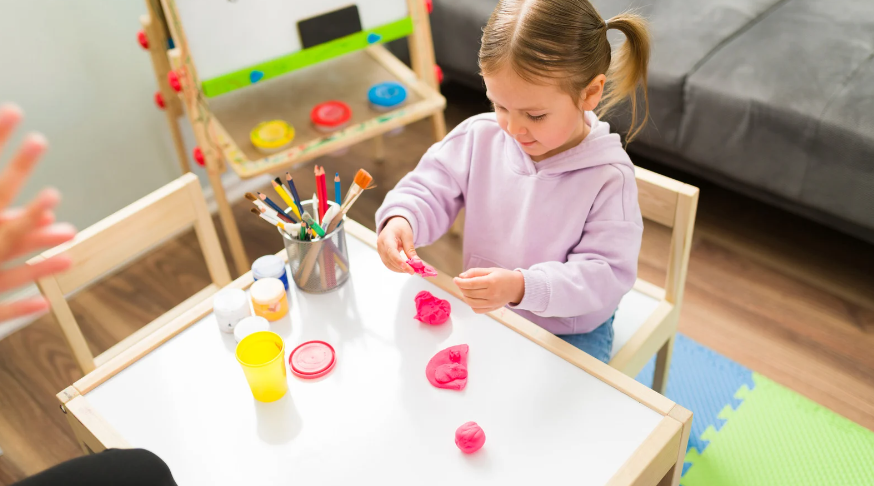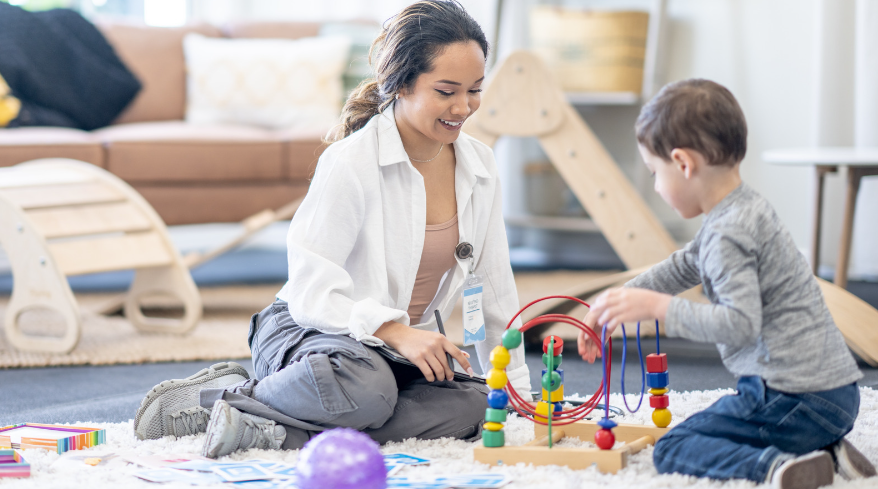Occupational Therapy (OT) is a lifeline for children who struggle with daily tasks, fostering their growth and independence. It’s not just about healing—it’s about empowering kids to thrive in daily life and unlocking their potential.
Recognizing and addressing developmental delays early can profoundly shape a child’s future. We’re delving into the necessity of occupational therapy for children to offer insights for parents and professionals on when this therapy might be crucial for a child’s successful growth.
Understanding Occupational Therapy
Occupational Therapy (OT) helps individuals develop skills needed for everyday living and working. Occupational therapists craft personalized plans targeting functional improvement. For children, OT focuses on play and learning activities to aid growth, differing from adults, who often require assistance restoring lost capabilities. This adaptability is key in meeting diverse developmental needs across age groups.
Signs That a Child May Need Occupational Therapy

Recognizing when your child might need occupational therapy can be challenging. However, understanding the potential signs can ensure your child gets the support they need to thrive. Here are some key areas to keep an eye on.
1. Developmental Delays in Motor Skills
Motor skills play a vital role in a child’s overall development. Delays can affect their ability to perform everyday tasks and participate in play.
Here’s what to keep an eye out for:
- Difficulty holding or manipulating small objects (e.g., using utensils, crayons).
- Trouble with coordination and balance (e.g., frequently tripping or bumping into objects).
- Delayed milestones, such as crawling, walking, or riding a bike.
- Poor hand-eye coordination.
2. Challenges in Sensory Processing
Sensory processing issues can make it hard for a child to respond appropriately to sensory inputs, leading to discomfort or behavioral issues.
Let’s take a peek at some signs:
- Overreaction to touch, sounds, smells, or lights.
- Seeking excessive sensory input (e.g., constantly touching objects or putting things in their mouth).
- Difficulty transitioning between activities or environments.
- Unusual responses to textures, such as refusal to wear certain clothing.
3. Difficulties with Daily Living Activities
Daily living activities include tasks like dressing, eating, and personal hygiene. Struggles in this area can significantly impact a child’s independence.
What does this look like in action?
- Trouble dressing or undressing, including fastening buttons or zippers.
- Challenges with feeding themselves (e.g., using utensils, chewing, and swallowing).
- Inconsistent hygiene habits, such as brushing teeth or washing hands.
- Dependence on caregivers for age-appropriate tasks.
4. Behavioral Issues
Behavioral issues can often signal underlying difficulties that might benefit from occupational therapy. Interventions can help address the root causes of these behaviors.
Behaviors to be aware of include:
- Frequent meltdowns or tantrums.
- Inability to cope with changes in routine.
- Avoidance or refusal of certain activities.
- Difficulty with attention and focus during tasks.
5. Struggles in Academic Performance
Academic struggles might not solely be about intellectual capacity but could be linked to developmental or sensory issues impacting learning.
Examples you might notice:
- Difficulty holding a pencil and forming letters or shapes.
- Trouble staying seated and focused during classroom activities.
- Challenges following instructions or completing tasks.
- Inconsistencies in academic performance despite apparent effort.
Benefits of Occupational Therapy for Children

Occupational therapy offers valuable support for children facing developmental challenges. Focusing on their unique needs helps improve their overall well-being and ability to engage in daily activities. Here are some key benefits your child might experience.
1. Improved Motor Skills and Physical Coordination
Occupational therapy enhances your child’s motor skills, aiding in activities like writing, cutting, and playing. Improved coordination contributes to a greater sense of confidence and independence.
2. Enhanced Sensory Processing and Integration
Therapists help children manage sensory input, making the world less overwhelming. This leads to better concentration, reduced anxiety, and a more enjoyable experience during daily activities.
3. Greater Independence in Daily Living Activities
Children gain skills for dressing, eating, and personal hygiene through specific strategies and exercises. This independence boosts their self-confidence and reduces reliance on others.
4. Better Coping Strategies for Frustration and Challenges
Occupational therapy teaches children effective ways to handle frustration and navigate challenges. This results in fewer meltdowns and a more positive outlook during difficult situations.
5. Positive Impacts on Social Skills and Self-Esteem
Therapists foster better communication and interaction skills, helping children form healthy relationships. Improved social skills and self-esteem mean they feel more confident in social settings.
6. Support for Academic and School-Related Tasks
Children receive assistance in managing school tasks like writing, following instructions, and staying organized. This support helps them perform better academically and stay engaged in the classroom.
When is OT Not Necessary?

Deciding if your child needs occupational therapy (OT) involves understanding their strengths and challenges. Not every issue requires OT—sometimes, what’s needed is support, patience, and time.
OT is a powerful tool for helping children overcome various obstacles, but it’s not always the answer. Here are instances when OT might not be necessary:
Temporary Challenges: If your child faces temporary setbacks that they’re quickly overcoming, such as adjusting to a new school or recovering from a minor injury, they may not need OT. Time and your support might be all they need.
Age-Appropriate Behaviors: Sometimes, behaviors that seem concerning, like intense focus on specific interests or occasional clumsiness, are age-appropriate and part of normal development. Unless these behaviors significantly interfere with daily life, OT may not be required.
Situational Issues: Problems that stem from situational factors, such as a challenging teacher-student relationship or an unsuitable learning environment, might resolve with changing circumstances rather than therapy.
Learning Preferences: Differences in learning styles or preferences don’t necessarily warrant OT. Some children are naturally more hands-on, while others thrive with auditory or visual learning. Tailoring learning experiences to match your child’s style can often address these issues.
Emotional and Behavioral Responses: It’s natural for children to exhibit a range of emotions and behaviors, including resistance to change or trying new activities. If these are occasional and do not significantly impact their or your family’s daily life, these might simply be areas where encouragement and understanding are needed rather than OT.
How OT Can Be Integrated into a Child’s Routine

Integrating occupational therapy (OT) into your child’s everyday life can boost their independence and confidence, providing support where it’s needed most—in the activities they do every day.
1. Integrating Occupational Therapy into Daily Routines
Working with Schools and Educators: Communication with your child’s teachers about their OT goals can ensure these are reinforced in the classroom. This can include modified seating arrangements for better posture or tailored classroom activities that align with their therapy objectives, like using scissors or handwriting exercises.
2. At-Home Activities and Strategies for Parents
Engage in simple, structured activities that mirror therapeutic practices, such as threading beads or cutting with child-safe scissors. Use daily routines like dressing or mealtime as opportunities for practice, focusing on skills like buttoning clothes or using utensils. Consistency and positive reinforcement at home can solidify gains made during therapy sessions.
3. Collaboration with Other Healthcare Professionals for a Holistic Approach
OT often intersects with the work of other specialists, like speech therapists or pediatricians. By aligning on strategies and shared goals, you can ensure a cohesive approach to your child’s development. Regularly updating each professional on progress and changes in therapy can foster an environment of holistic care, addressing all facets of your child’s growth.
Occupational Therapy Process for Children

- Assessment: The process starts with a comprehensive assessment where the therapist observes and evaluates a child’s skills. This crucial step forms the foundation for a personalized therapy plan.
- Goal-setting: Following the assessment, clear, collaborative goals are established, incorporating input from the child and their support system. These goals serve as a base for the targeted therapy journey.
- Intervention: In the intervention phase, the child participates in activities tailored to be enjoyable and therapeutic, addressing the set goals. Each session is purposefully designed to blend fun with skill development.
- Re-assessment: The cycle concludes with reassessment, measuring the child’s progress and fine-tuning the therapy plan if needed. It ensures therapy effectiveness and adaptability to the child’s evolving requirements.
Final Thoughts
Recognizing the need for occupational therapy (OT) is crucial in unlocking a child’s potential, and with the targeted support it offers, children can experience transformative improvements in their daily lives. If you’re ready to explore these possibilities, Kemit Academy is at your service. We encourage you to reach out and discover the positive impact our customized OT services can have on your child’s development and overall well-being. Let’s join forces to pave the way for their growth and success.

